The AMD Ryzen Threadripper 3960X and 3970X Review: 24 and 32 Cores on 7nm
by Dr. Ian Cutress, Andrei Frumusanu & Gavin Bonshor on November 25, 2019 9:05 AM ESTCPU Performance: Web and Legacy Tests
While more the focus of low-end and small form factor systems, web-based benchmarks are notoriously difficult to standardize. Modern web browsers are frequently updated, with no recourse to disable those updates, and as such there is difficulty in keeping a common platform. The fast paced nature of browser development means that version numbers (and performance) can change from week to week. Despite this, web tests are often a good measure of user experience: a lot of what most office work is today revolves around web applications, particularly email and office apps, but also interfaces and development environments. Our web tests include some of the industry standard tests, as well as a few popular but older tests.
We have also included our legacy benchmarks in this section, representing a stack of older code for popular benchmarks.
All of our benchmark results can also be found in our benchmark engine, Bench.
Speedometer 2: JavaScript Frameworks
Our newest web test is Speedometer 2, which is a accrued test over a series of javascript frameworks to do three simple things: built a list, enable each item in the list, and remove the list. All the frameworks implement the same visual cues, but obviously apply them from different coding angles.
Our test goes through the list of frameworks, and produces a final score indicative of ‘rpm’, one of the benchmarks internal metrics. We report this final score.
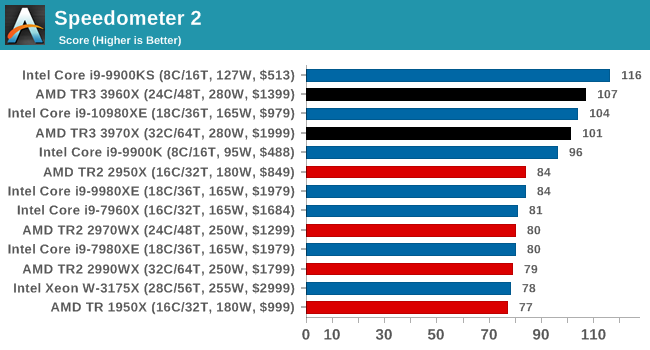
Google Octane 2.0: Core Web Compute
A popular web test for several years, but now no longer being updated, is Octane, developed by Google. Version 2.0 of the test performs the best part of two-dozen compute related tasks, such as regular expressions, cryptography, ray tracing, emulation, and Navier-Stokes physics calculations.
The test gives each sub-test a score and produces a geometric mean of the set as a final result. We run the full benchmark four times, and average the final results.
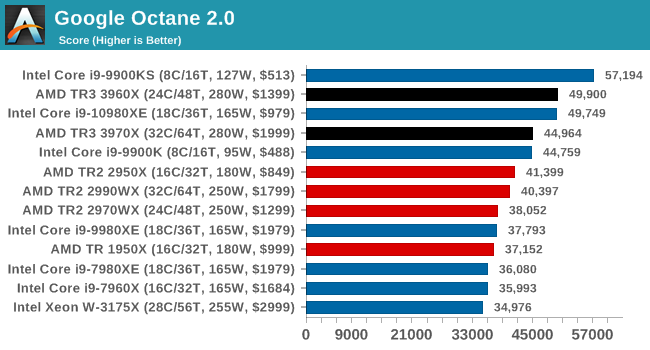
Mozilla Kraken 1.1: Core Web Compute
Even older than Octane is Kraken, this time developed by Mozilla. This is an older test that does similar computational mechanics, such as audio processing or image filtering. Kraken seems to produce a highly variable result depending on the browser version, as it is a test that is keenly optimized for.
The main benchmark runs through each of the sub-tests ten times and produces an average time to completion for each loop, given in milliseconds. We run the full benchmark four times and take an average of the time taken.

3DPM v1: Naïve Code Variant of 3DPM v2.1
The first legacy test in the suite is the first version of our 3DPM benchmark. This is the ultimate naïve version of the code, as if it was written by scientist with no knowledge of how computer hardware, compilers, or optimization works (which in fact, it was at the start). This represents a large body of scientific simulation out in the wild, where getting the answer is more important than it being fast (getting a result in 4 days is acceptable if it’s correct, rather than sending someone away for a year to learn to code and getting the result in 5 minutes).
In this version, the only real optimization was in the compiler flags (-O2, -fp:fast), compiling it in release mode, and enabling OpenMP in the main compute loops. The loops were not configured for function size, and one of the key slowdowns is false sharing in the cache. It also has long dependency chains based on the random number generation, which leads to relatively poor performance on specific compute microarchitectures.
3DPM v1 can be downloaded with our 3DPM v2 code here: 3DPMv2.1.rar (13.0 MB)
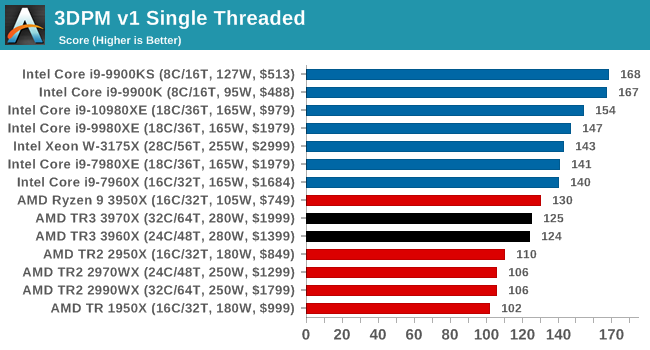
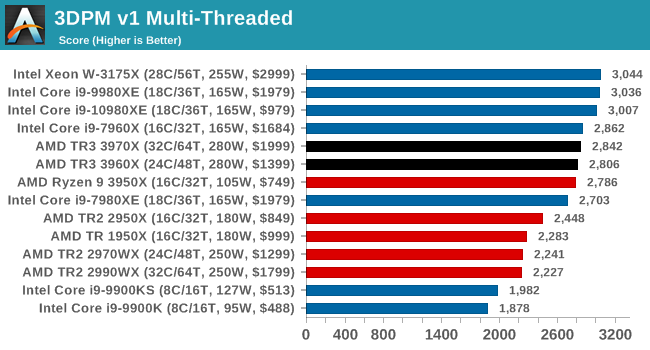
x264 HD 3.0: Older Transcode Test
This transcoding test is super old, and was used by Anand back in the day of Pentium 4 and Athlon II processors. Here a standardized 720p video is transcoded with a two-pass conversion, with the benchmark showing the frames-per-second of each pass. This benchmark is single-threaded, and between some micro-architectures we seem to actually hit an instructions-per-clock wall.
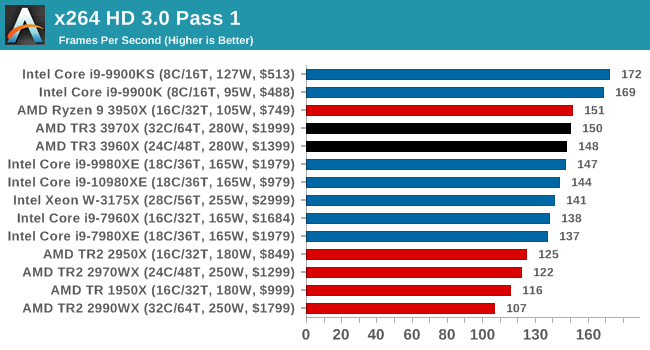
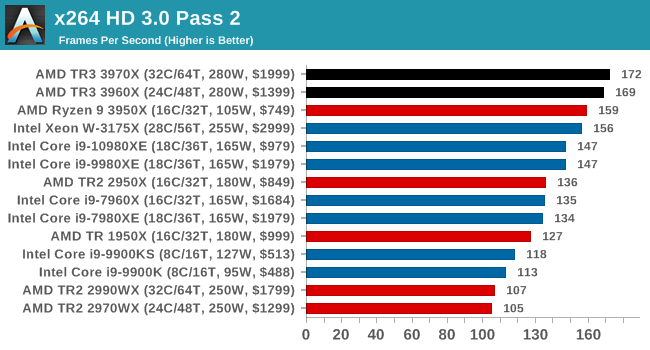
GeekBench4: Synthetics
A common tool for cross-platform testing between mobile, PC, and Mac, GeekBench 4 is an ultimate exercise in synthetic testing across a range of algorithms looking for peak throughput. Tests include encryption, compression, fast Fourier transform, memory operations, n-body physics, matrix operations, histogram manipulation, and HTML parsing.
I’m including this test due to popular demand, although the results do come across as overly synthetic, and a lot of users often put a lot of weight behind the test due to the fact that it is compiled across different platforms (although with different compilers).
We record the main subtest scores (Crypto, Integer, Floating Point, Memory) in our benchmark database, but for the review we post the overall single and multi-threaded results.












245 Comments
View All Comments
Slash3 - Tuesday, November 26, 2019 - link
AnandTech frustratingly doesn't seem to ever list their memory subtimings, but as they test at "JEDEC" standard, it may be as loose as 2933 CL19-19-19 vs your 2933 CL14. This could easily account for the difference in benchmark results.alufan - Monday, November 25, 2019 - link
So Thread ripper is here, I will never have a use for this chip but I want one...just because, probably the single biggest uplift in CPU performance for a great many years.Still 10 intel featuring articles on the main page vs 4 featuring AMD though, shame really and it would have been nice for you to have a proper dig at intel for its pathetic attempt to skew CPU bench results by moving the embargo forward, try taking a tip off linus man he told it like it was as have many others.
Grobert783 - Monday, November 25, 2019 - link
So many cores and yet no one cares PLUS we all know AMD sucks. Thank youyeeeeman - Monday, November 25, 2019 - link
LolXyler94 - Monday, November 25, 2019 - link
Ah yes, the infamous "Nobody cares" argument of a fanboy.And yet you cares enough to click the article, go to the comment section, and write this comment. I won't comment about your other comment though, clearly you didn't RTFA
darwi - Monday, November 25, 2019 - link
With so much cores Anandtech should consider virtualization benchmark/uses casesthere is some good automated Lab Scripts available.
On Windows Nested Virtualization is still not enabled on AMD Processor.
-> still not announced for Windows 20H1, perhaps for 2OH2 since major overhaul for Azure is underway.
Ryzen Master is still incompatible with VBS (Virtualization based Security).
This situation prevent to test some features in Windows VM :
- With more and more feature relying on virtualization (WSL, Security, workload isolation, ...)
- For advanced scenarios (Labs for testing infrastructure deployment, ESXi, hyper-v, compiler, etc...)
By ignoring the 1k segment AMD could overplay their advantages :
- the cpu is only a part of the package (you have to add a beefy psu and cooling system and a decent amount
of RAM) if you want to make a meaningfull use of such platform.
- the moherboad price take a major rise (Apple accessories manufacturer syndrom ?) - without high ends feature regarding connectivity
where are the multi-gig network and Thunderbolt ports ?, but RGB pins are plenty ...
- forcing the early TR adopters to a 2k-2,5k investment to jump to the TR3+ architecture (if cooler and RAM, PSU remain the same)
and chipset reset could do some damage too.
And finally the 10980XE (with more PCI 3 lanes, and more memory) will not be the best but enough and more affordable.
I'm a an owner of TR 1950X.
Questions :
> Nested Virtualization will eventually comming to AMD ? (for a future interview with AMD CEO/CTO)
> Air Cooling is it still suitable for TR3 ?
And thanx to Anandtech for those reviews and the worth of drilling down into details.
That's my 2cents.
Irata - Monday, November 25, 2019 - link
Wait, what ? The 10980XE has more PCIe lanes than TR3?And the rest...is pot legal where you live?
darwi - Monday, November 25, 2019 - link
I was comparing with the nearest AMD offrer to the 10908XE v: The Ryzen 3950X.Furthermore the PCI4 cards are very few for the moment.
May be there is some room for a TR3 3950X like the TR 1920 in his time.
The 1K is for 1K$.
lobz - Tuesday, November 26, 2019 - link
I usually don't do drugs but I'll have some from what you're having...Xyler94 - Monday, November 25, 2019 - link
In what world is 60 PCIe 4.0 lanes less than 48 PCIe 3.0 lanes?You do know... that PCIe 4 is backwards compatible, so Threadripper has effectively 60 lanes of PCIe 3, right? I don't know about you... but 60 is more than 48...